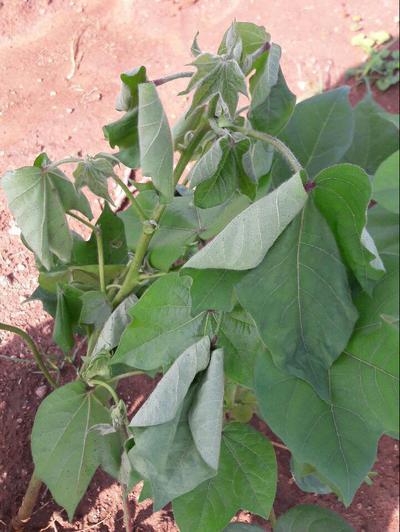Parawilt
Parawilt
Other
In a Nutshell
- Wilting and discoloration of leaves.
- Early shedding of bolls and leaves.
Can also be found in
Symptoms
Parawilt, also known as 'sudden wilt', occurs sporadically distributed in fields and in an untimely manner. There is no real field pattern associated with this disorder and it is often confused with diseases caused by pathogens. Main symptoms are wilt and discoloration of leaves. Leaf color may change from chlorotic to bronze or red and is later followed by drying of the tissues. This disorder especially affects plants with a rapid growth, a large canopy and a heavy boll load. Early shedding of bolls and leaves and early opening of bolls can occur. The plants might recover but yield will be negatively affected.
Recommendations

Organic Control
There are no biological control measures for parawilt. To avoid this disorder, it is essential to adjust irrigation and fertilization of the cotton plants and plan a good drainage of the soil.

Chemical Control
Always consider an integrated approach with preventive measures together with biological treatments if available. There are no chemical treatments to treat parawilt. However, you can start by removing excess of water through drainage channel. Prepare then a solution of 15gm urea, 15 gm muriate of potash and 2 gm copper oxychloride in 1 liter of water. Add 100 -150 ml water near the root zone of plant . This solution provides instant nutrient to plant and the fungicide prevents fungal infection .
What caused it?
Parawilt is a physiological disorder, which means that no fungi, bacteria, viruses or similar are involved. Contrary to other diseases or stresses that cause similar symptoms in cotton plants, parawilt develops in matter of hours and without a specific spatial pattern. The sporadic distribution and untimely occurrence are typical signs of parawilt. It is now known that the disorder is due to the sudden accumulation of water around the root (after a downpour or excess irrigation) followed by hot temperatures and blazing sunshine. Rapid plant growth and nutrient imbalance are also involved. Soils with high clay content or soils with poor drainage increase the possibility of plants developing this disorder.
Preventive Measures
- Plant varieties or hybrids tolerant to parawilt.
- Assure good drainage of the fields to prevent water logging.
- Avoid excessive or too frequent irrigation unless necessary due to a specific growth phase and/or dry conditions.
- Monitor crops regularly, particularly after heavy rains followed by high temperatures and blazing sunshine.
- Do not fertilize in excess to avoid excessive grow (e.g.
- large canopy and heavy boll load).
- Modify sowing dates to avoid causes of the disorder (heavy rains and sunshine).



